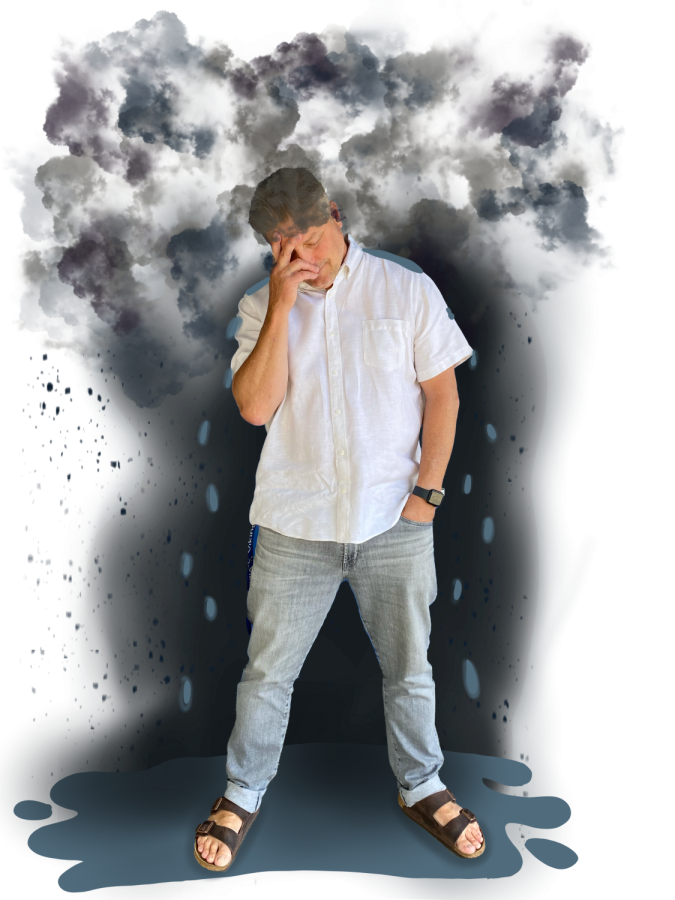Teachers endure burnout
Graphic illustration by Anwen Huang and Neha Ayyer
Declining mental health is not a crisis affecting that only affects students, but one that teachers face as well.
May 3, 2022
In the wake of a growing mental health epidemic, FUHSD has implemented a variety of emotional support services, from Homeroom modules to the HAERT Program. However, declining mental health is not a crisis affecting that only affects students, but one that teachers face as well. Post-isolation, many school districts have seen increased levels of stress, particularly burnout, among teachers. To combat this rise, FUHSD has sought to support the emotional wellbeing of its staff.
The RAND Corporation’s 2021 State of the U.S. Teacher Survey found that 27% of teachers experienced depression-like symptoms as a result of the COVID-19 pandemic, a rate that almost triples the percentage in other adults. This upward trend among teachers follows others, including an increase in symptoms consistent with generalized anxiety and less job satisfaction. While FUHSD alleviated some of the hardships students faced during distance learning by changing the grading system to be pass-fail and making Wednesdays asynchronous, teachers continued carrying a similar workload to pre-isolation school, on top of being forced to adapt to an online environment.
Many teachers found it difficult to engage their students, who were reluctant to unmute or turn on their cameras. Remote learning also proved to be a hotbed for unprecedented problems such as Internet issues, unfamiliarity with new technology, student absences and Zoom-bombing. Online social behaviors, coupled with a lack of personal connection with their students, caused distance learning to be a highly ungratifying and an impersonal experience for some teachers.
“Many of the challenges I faced last year were in trying to figure out how much students were learning,” history teacher Nhat Nguyen said. “With remote learning, it’s hard to maintain the level of interaction that is necessary for learning.”
Distance learning also blurred the boundaries between a teacher’s personal and work life. The State of the U.S. Teacher Survey found that one-third of teachers had to care for their own children while teaching during the pandemic, creating an additional level of difficulty when managing a lesson at home. Moreover, students almost exclusively see their teachers in class, which can cause interactions outside of the classroom and exposure to a teacher’s personal life to be uncomfortable for students, leading to an overall lack of empathy and consideration for teachers.
“I know that students have a lot to deal with and a lot of stress, so I don’t fault them for not understanding what teachers are going through,” Nguyen said. “But there are times when students act or behave in ways that make it seem like they expect that a teacher has nothing else to worry about when we have other things to do.”
Additionally, the competitive culture at Lynbrook means that teachers are held to lofty standards in order to satisfy academic demands.
“If you aren’t on top of your planning and your curriculum, you kind of get eaten alive at a school like Lynbrook,” Spanish teacher Kim Revilla said. “As a teacher, you have to be on top of your game all the time because the kids are learning at such a high level that they’re going to notice even small mistakes, which puts extra pressure on teachers. At the same time, I do want students to know that we all make mistakes and I try to acknowledge when I make a mistake. We are all going to make mistakes, but it’s what we do after that is important.”
The well-being of both students and teachers is important because they influence each other: A teacher’s mental health affects how they perform and consequently impacts students, and the stress of students affects the environment of a teacher’s classroom.
“We often say that classrooms are a collective nervous system,” said Beck Engwerda, director of Strategic Partnerships at Mindful Schools, an organization that pushes for a healthy culture in schools. “If everyone is positive and feeling great within the room, you can pick up on that. And on the other side if others are feeling really stressful, then people absorb that as well.”
Since the beginning of the school year, the Lynbrook administration and PTSA have taken teacher well-being and mental health into particular care, hosting multiple events including Staff Appreciation Week, during which students shared kind words to teachers, and Staff Care Week, during which teachers were delighted with a variety of stress-relieving treats on campus, ranging from 15-minute massages to aromatherapy cinnamon rolls. Other teacher-care events include meditation and yoga sessions and campus walks. District policies also provide ample personal necessity leave and sick days.
“Our aim for these events is to recognize self care and make teachers feel appreciated,” Principal Maria Jackson said. “But if a teacher is really struggling with their mental health, there are district resources that can help.”
The Employee Assistance Program and WorkLife Services Benefit are some of the resources available on the FUHSD website, offering a network of financial, legal experts and clinicians to district staff. Another more recent addition to the district’s resources is Care Solace, a program available to every FUHSD community member, that focuses on providing substance abuse and mental health help. Although it has mostly been utilized by teenagers in the district, 16% of Care Solace users in FUHSD were adults.
“Over the last few years, we have also been increasing the number of conversations and actions surrounding social-emotional learning,” Associate Superintendent Trudy Gross said. “And while that has been largely focused on students, the work that is occurring with staff members is part of wellness for all of us. So really, anytime we are working to create a more positive climate, it benefits everyone.”
Aside from events and resources that are administration-provided, well-being is extremely necessary for teachers to prioritize and take into their own hands.
“I think it’s important to be kind to yourself because it really has been a hard couple of years,” Revilla said. “I try to be honest with myself about where I am, and sometimes that means acknowledging that I just don’t have the energy to do X, Y and Z. I’ve been trying to take the pressure off of feeling like we have to get to certain places in our curriculum and trying to be patient with myself and my students; it’s definitely a work in progress.”
Even the smallest actions from students can go a long way to relieve a part of teachers’ stress.
“Students can help teachers by just communicating,” Nguyen said. “Even criticism is better than silence, since silence can lead a teacher feeling unsure of how to help students. The communication doesn’t even have to be about school; a simple ‘How has your day been?’ allows for a teacher to feel like there’s at least some kind of interaction going on.”
Creating a healthy campus environment takes multiple approaches; district-provided resources, personal action and empathy from the community all uplift the mental health of students and staff alike. The well-being of teachers directly correlates to the classroom, the quality of education received by students and a positive classroom environment for all. By making an effort to bring to light and improve teacher mental health, FUHSD helps staff serve the community to their highest capability.





























































